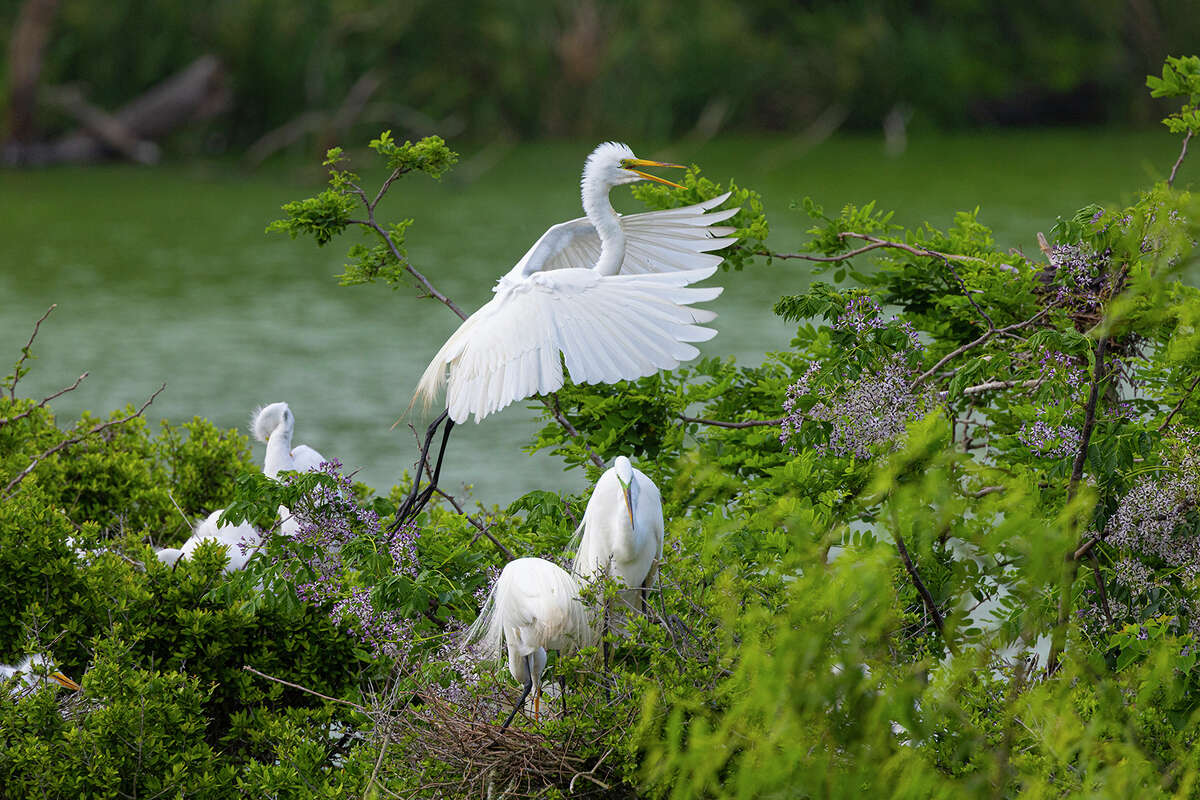It's nesting season for spectacular plumed wading birds at Houston Audubon
Gary Clark, Correspondent
March 9, 2023Updated: March 9, 2023 11:14 a.m.
 1of7A great egret flies to its nest at the rookery at Houston Audubon's Smith Oaks Bird Sanctuary in High Island. Photo Credit: Kathy Adams Clark. Restricted use.Kathy Adams Clark/Kathy Adams Clark/KAC Productions 1of7A great egret flies to its nest at the rookery at Houston Audubon's Smith Oaks Bird Sanctuary in High Island. Photo Credit: Kathy Adams Clark. Restricted use.Kathy Adams Clark/Kathy Adams Clark/KAC Productions 
Long-legged wading birds — great egrets in flowing white plumes and roseate spoonbills in radiant pink plumes — stage a breeding ballet at Houston Audubon Society's Smith Oaks Bird Sanctuary in High Island, about 90 miles east of Houston.
Multitudes of elaborately plumed birds will perform their courtship dances on a platform of densely packed trees, called a rookery, that rises from an island in Clay Bottom Pond at the sanctuary. The Kathrine G. McGovern Canopy Walkway is an elevated wooden structure that winds along the banks of the pond to observation platforms near treetop level.
The birds aren't showing off their elegant colors or flying about and uttering those guttural sounds for our entertainment. They're engaged in the frenetic work of forming breeding partners and building nests. Breeding activity is in the early stages but will peak during the last two weeks of March and the first two weeks of April.
Diverse species at the rookery, such as egrets, herons, spoonbills and cormorants, are known as colonial water birds because they breed in large assemblies. They crowd into trees or other vegetation surrounded by water to protect their nests from predators.
Houston Audubon’s rookery
Market hunters of the 19th century slaughtered North America's breeding wading birds to supply milliners in New York and London with decorative plumes for women's high fashion hats.
The National Audubon Society began as a drive to stop the slaughter, which resulted in the Migratory Bird Treaty Act of 1918.
Houston Audubon's rookery at Smith Oaks Bird Sanctuary in High Island is open to visitors daily from dawn to dusk, but viewing is best early mornings and late afternoons.
Take binoculars and a camera. A spotting scopes is helpful but not essential.
Watch a YouTube video of the Kathrine G. McGovern Canopy Walkway at youtube.com/watch?v=mXDRlwmtvxk
Entrance fees and information at houstonaudubon.org
Fearsome alligators occupy the water encircling the rookery. They stay concealed along the muddy banks but will move through the water like dreadnoughts to chomp down other predators, including coyotes and raccoons, swimming across the pond to pillage bird nests with eggs and chicks.
A male great egret will fly around the females in wide circles with wings flapping in loud whooshing sounds. Once he attracts a female's attention, he'll perch on a branch, ruffle his feathers and crane his beak upward, while uttering a croaking yodel.
A male roseate spoonbill will court a female by commandeering a nest site, shaking nearby twigs with his large spatula-shaped beak and bobbing his head up and down. Once the female chooses him for mating, the pair will slap their big wide beaks together as though kissing and then rub their bodies together as though hugging.
Use a pair of binoculars or a spotting scope to view nests holding greenish-blue eggs of egrets or the cream-colored, brown-spotted eggs of roseate spoonbills. Watch a female gently adjust a nest with her beak and then flatten her body over the eggs to brood them.
|





 1of7A great egret flies to its nest at the rookery at Houston Audubon's Smith Oaks Bird Sanctuary in High Island. Photo Credit: Kathy Adams Clark. Restricted use.
1of7A great egret flies to its nest at the rookery at Houston Audubon's Smith Oaks Bird Sanctuary in High Island. Photo Credit: Kathy Adams Clark. Restricted use.
